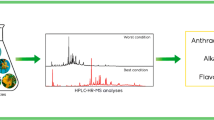Abstract
A fast and selective ultrahigh-performance liquid chromatography diode array detector (UHPLC-DAD) method combined with an off-line solid phase extraction (SPE) protocol was established to monitor destruxins (dtxs), a secondary metabolite class of highly bioactive cyclic depsipeptides. Sample purification via SPE was tailored to remove both more polar and apolar matrix constituents by applying analyte class-selective washing and elution conditions. To separate and detect destruxin congeners an UHPLC-DAD system hyphenated to a quadrupole–time-of-flight (Q-TOF) hybrid mass spectrometer was utilized. Analyses were performed on a sub-2-μm-particle-size RP-18 column with an acidified (0.02 % acetic acid) 12 min water/acetonitrile solvent gradient. In the dtx congener elution zone 22 chromatographic peaks were separated. Four of these were identified by comparison with reference materials as dtx A, dtx B, dtx E, and dtx E-diol; 16 were tentatively assigned as known or novel dtx congeners by the analysis of high resolution UHPLC-DAD-QTOF-MS/MS data recorded in the positive electrospray ionization (ESI) mode. The applicability of the UHPLC-DAD assay to investigate biological materials in a qualitative and quantitative manner was proven by the application of the platform to monitor the dtx production profile of three Metarhizium brunneum strain fungal culture broths.





Similar content being viewed by others
References
Bischoff JF, Rehner SA, Humber RA (2009) A multilocus phylogeny of the Metarhizium anisopliae lineage. Mycologia 101:512–530
Kepler RM, Rehner SA (2013) Genome-assisted development of nuclear intergenic sequence markers for entomopathogenic fungi of the Metarhizium anisopliae species complex. Mol Ecol Resour 13:210–217
Petzold-Maxwell JL, Jaronski ST, Clifton EH, Dunbar MW, Jackson MA, Gassmann AJ (2013) Interactions among Bt maize, entomopathogens, and rootworm species (Coleoptera: Chrysomelidae) in the field: effects on survival, yield, and root injury. J Econ Entomol 106:622–632
Zimmermann G (2007) Review on safety of the entomopathogenic fungus Metarhizium anisopliae. Biocontrol Sci Tech 17:879–920
European Commission (2011) Commission implementing regulation (EU) No 540/2011 of 25 May 2011 implementing Regulation (EC) No 1107/2009 of the European Parliament and of the Council as regards the list of approved active substances, OJEU, L 153/1-186. http://eur-lex.europa.eu/LexUriServ/LexUriServ.do?uri=OJ:L:2011:153:0001:0186:EN:PDF. Accessed 21 Apr 2014
Pedras MSC, Irina Zaharia L, Ward DE (2002) The destruxins: synthesis, biosynthesis, biotransformation, and biological activity. Phytochemistry 59:579–596
Nakagawa H, Takami M, Udagawa N, Sawae Y, Suda K, Sasaki T, Takahashi N, Wachi M, Nagai K, Woo J (2003) Destruxins, cyclodepsipeptides, block the formation of actin rings and prominent clear zones and ruffled borders in osteoclasts. Bone 33:443–455
Hinaje M, Ford M, Banting L, Arkle S, Khambay B (2002) An investigation of the ionophoric characteristics of destruxin A. Arch Biochem Biophys 405:73–77
Tsunoo A, Kamijo M (1999) Non-cyclic AMP-dependent, positive inotropic cyclodepsipeptides with negative chronotropy. J Pharmacol Exp Ther 290:1006–1012
Dornetshuber-Fleiss R, Heffeter P, Mohr T, Hazemi P, Kryeziu K, Seger C, Berger W, Lemmens-Gruber R (2013) Destruxins: fungal-derived cyclohexadepsipeptides with multifaceted anticancer and antiangiogenic activities. Biochem Pharmacol 86:361–377
Dumas C, Matha V, Quiot JM, Vey A (1996) Effects of destruxins, cyclic depsipeptide mycotoxins, on calcium balance and phosphorylation of intracellular proteins in lepidopteran cell lines. Comp Biochem Physiol C Pharmacol Toxicol Endocrinol 114:213–219
Strauch O, Strasser H, Hauschild R, Ehlers RU (2011) Proposals for bacterial and fungal biocontrol agents. In: Ehlers RU (ed) Regulation of biological control agents. Spinger, Dordrecht
Strasser H, Hutwimmer S, Burgstaller W (2011) Metabolite toxicology of fungal biocontrol agents: risks and risk assessment. In: Ehlers RU (ed) Regulation of biological control agents. Spinger, Dordrecht
Seger C, Sturm S, Stuppner H, Butt TM, Strasser H (2004) Combination of a new sample preparation strategy with an accelerated high-performance liquid chromatography assay with photodiode array and mass spectrometric detection for the determination of destruxins from Metarhizium anisopliae culture broth. J Chromatogr A 1061:35–43
Potterat O, Wagner K, Haag H (2000) Liquid chromatography-electrospray time-of-flight mass spectrometry for on-line accurate mass determination and identification of cyclodepsipeptides in a crude extract of the fungus Metarrhizium anisopliae. J Chromatogr A 872:85–90
Seger C, Eberhart K, Sturm S, Strasser H, Stuppner H (2006) Apolar chromatography on Sephadex LH-20 combined with high-speed counter-current chromatography. J Chromatogr A 1117:67–73
Jegorov A, Havlicek V, Sedmera P (1998) Rapid screening of destruxins by liquid chromatography/mass spectrometry. J Mass Spectrom 33:274–280
ICH (2006) ICH harmonized tripartite guideline validation of analytical procedures: text and methodology Q2(R1). http://www.ich.org/fileadmin/Public_Web_Site/ICH_Products/Guidelines/Quality/Q2_R1/Step4/Q2_R1__Guideline.pdf. Accessed 21 Apr 2014
Skrobek A, Butt TM (2005) Toxicity testing of destruxins and crude extracts from the insect-pathogenic fungus Metarhizium anisopliae. FEMS Microbiol Lett 251:23–28
Wang H, Hutwimmer S, Strasser H, Burgstaller W (2009) Destruxin production of Metarhizium anisopliae under carbon and nitrogen exhaustion. J Basic Microbiol 49:404–411
Hutwimmer S, Wagner S, Affenzeller M, Burgstaller W, Strasser H (2008) Algorithm-based design of synthetic growth media stimulating virulence properties of Metarhizium anisopliae conidia. J Appl Microbiol 105:2026–2034
Wang C, Skrobek A, Butt TM (2004) Investigations on the destruxin production of the entomopathogenic fungus Metarhizium anisopliae. J Invertebr Pathol 85:168–174
Loutelier C, Cherton JC, Lange C, Traris M, Vey A (1996) Studies on the dynamics of the production of destruxins by Metarhizium anisopliae: direct high-performance liquid chromatographic and fast atom bombardment mass spectrometric analysis correlated with biological activity tests. J Chromatogr A 738:181–189
Acknowledgment
This research has been supported by the European Community’s Seventh Framework Programme grant (FP7_ENV.2011.3.1.9-1 ECO-INNOVATION, INBIOSOIL, Grant Agreement No. 282767).
Author information
Authors and Affiliations
Corresponding author
Rights and permissions
About this article
Cite this article
Taibon, J., Sturm, S., Seger, C. et al. Development of a fast and selective UHPLC-DAD-QTOF-MS/MS method for the qualitative and quantitative assessment of destruxin profiles. Anal Bioanal Chem 406, 7623–7632 (2014). https://doi.org/10.1007/s00216-014-8203-z
Received:
Revised:
Accepted:
Published:
Issue Date:
DOI: https://doi.org/10.1007/s00216-014-8203-z




